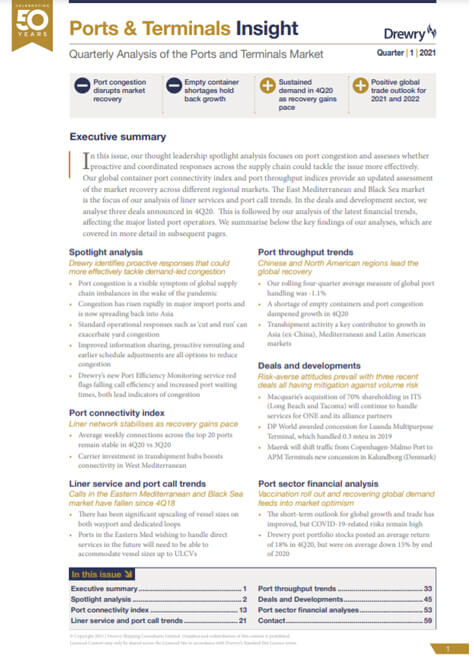News & Events
North Europe ports productivity under pressure due to higher exchanges
London, UK, 10 June 2022 – Container terminal productivity across Northwest European ports has deteriorated significantly over the past three years due to the challenges of handling larger exchanges, as carriers have consolidated port calls in the face of volatile cargo demand, according to the latest Ports & Terminals Insight report published by Drewry.
New analysis powered by Drewry AIS analytics shows that average call duration at the main Northwest European ports increased by over 50% in 1Q22 compared to their pre-pandemic average, before falling back to 37% above pre-pandemic in May 2022. Drewry’s analysis indicates that average port time per call peaked at 2.3 days in February, 58% above the pre-pandemic 2019 average.
As can be seen from the chart, the bulk of this port time is taken up at the terminal, representing around 60%, while pre-berth waiting forms a much smaller 20%, on average. This contrasts sharply with the performance at the main West Coast North America ports which suffered from much more severe pre-berth waiting delays, which peaked at 4.3 days in October 2021 - representing over 55% of average port call duration, according to Drewry’s AIS-based analysis.
“Weaker demand recovery, uncongested alternative ports and established feeder networks has meant far less vessel queueing in European ports,” commented Drewry’s head of ports and terminals research Eleanor Hadland. “But a spike in vessel call exchanges has created a much larger headache for European terminal operators.”
Figure 1: Average call duration across North West Europe ports

The deterioration in Northwest European port productivity has occurred despite weaker throughput levels than during the pre-pandemic period. Traffic across the region’s four main ports of Antwerp, Rotterdam, Bremerhaven and Hamburg was 3.5% lower in 1Q22 compared to the same period in 2019 and the decline in the number of vessel calls was even steeper at 15.1%, according to Drewry. Nor have average vessel sizes changed much over this period. But Drewry estimates that average exchanges have increased markedly, rising by an average 14% across the four main ports in the three years to 1Q22.
To counter the impact of volatile demand patterns and risk of congestion, carriers have adjusted their schedules to reduce the number of port calls per rotation, leading to large increases in parcel sizes.
Figure 2: Terminal productivity at Antwerp, Bremerhaven and Hamburg

According to Drewry’s latest AIS powered analytics, average exchanges rose by over 20% in Antwerp and 12% in Bremerhaven over the three years to 1Q22. As a result, both ports saw their terminal productivity deteriorate over 30%, as measured by days per 1,000 teu of throughput.
“The steep increase in cargo exchanges is posing similar challenges for terminal operators as the prior spate of vessel upsizing,” added Hadland. “But the difference is that vessel upsizing was planned well in advance, whereas the 2021-22 ramp up in cargo exchanges have happened much faster and with little notice.”
About Drewry Ports and Terminals Insight
The Ports and Terminal Insight is a quarterly report (PDF) covering the latest developments in the container ports and terminals market, accompanied by a new monthly report (PDF) providing regular port congestion and performance monitoring (powered by Drewry AIS analytics). It looks behind the data and topical issues to answer both the ‘cause’ and ‘effect’ questions that matter most to senior industry stakeholders.
Find out more
© Copyright 2025 | Drewry Shipping Consultants Limited. All Rights Reserved. Website Terms of Use | Privacy Policy




